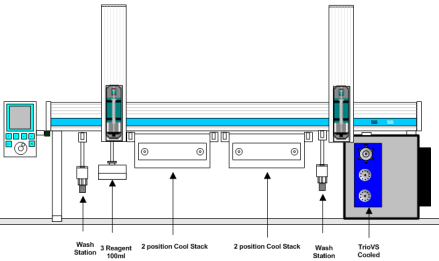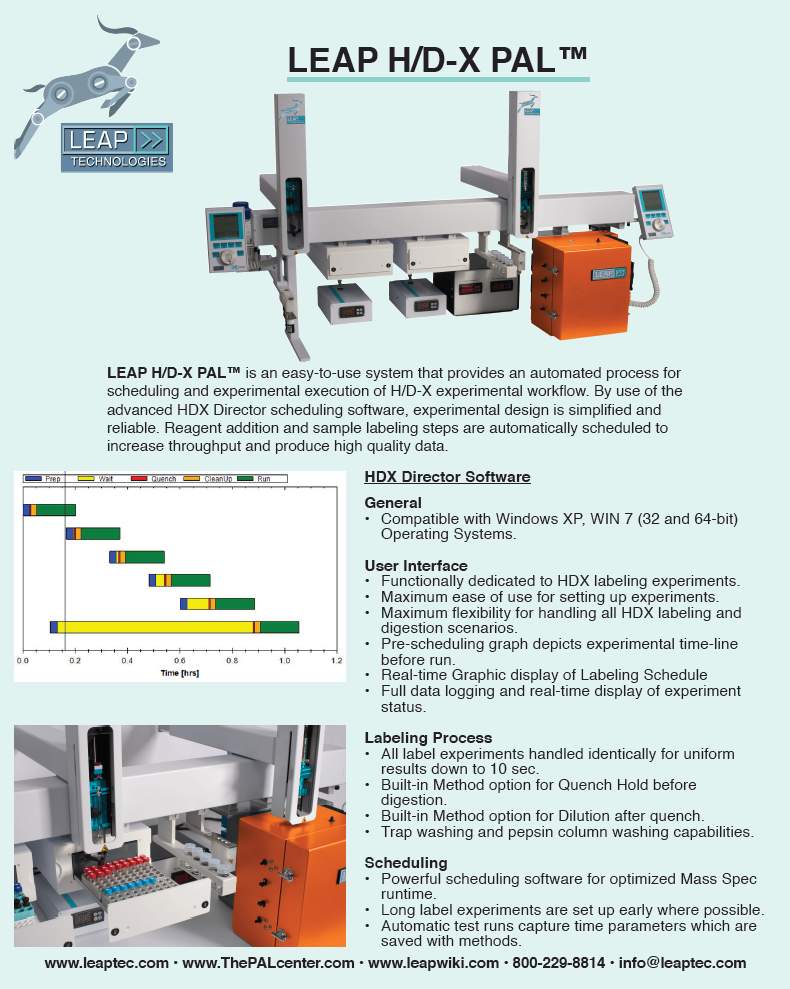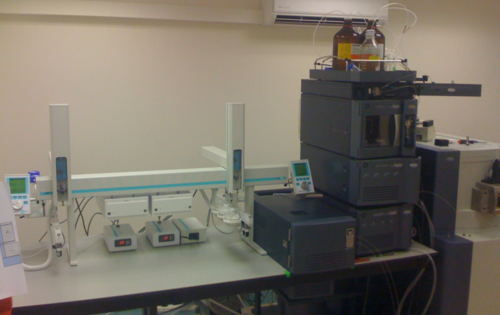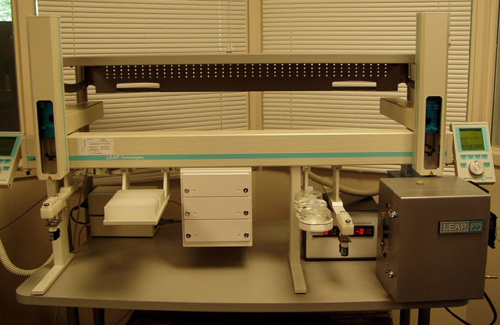Hydrogen Deuterium Exchange
From LEAP
m |
Current revision (16:56, 1 August 2013) (view source) (→Other Reference material) |
||
| (130 intermediate revisions not shown.) | |||
| Line 1: | Line 1: | ||
{{LSApp | {{LSApp | ||
|name = Hydrogen Deuterium Exchange | |name = Hydrogen Deuterium Exchange | ||
| - | |image = | + | |image = HDX.png |
| - | |type = | + | |type = '''SPECIAL''' |
|id = HD-X PAL | |id = HD-X PAL | ||
| - | |description = | + | |description = Automated Sample Prep for HD-X |
}} | }} | ||
| + | {{logo}} | ||
| - | |||
| - | |||
| - | === | + | === General Description === |
| - | + | '''Hydrogen Deuterium Exchange (HD-x)''' is an experimental technique to obtain structural data on proteins. It relies on the accurate measurement of the degree of labeling of the protein by deuterated hydrogen during a precisely measured labeling interval. The labeling reaction is stopped by addition of a quenching reagent, and loss of label between the quench step and analysis (usually by LCMS) is minimized by keeping the reactants at a temperature close to zero degrees Celsius. <br/><br/> | |
| + | The technique is difficult to perform manually due to the demands for precise timing and reproducing exactly the same experimental conditions. Automation solves both of these challenges. [http://www.leaptec.com/ LEAP Technologies] has developed a robotic solution to the sample prep and introduction to the LCMS. It consists of a [http://www.leapwiki.com/mediawiki/index.php?title=TwinPAL Twin PAL] workstation configured as shown below. There are two cooled zones on the workstation: A [http://www.leapwiki.com/mediawiki/index.php?title=Single_Drawer_Cooler cooled stack] at 1oC for the samples and labeled reactants and a [http://www.leapwiki.com/mediawiki/index.php?title=Valve_Cooler cooled chromatography module] which contains the injection valve, the [http://www.leapwiki.com/mediawiki/index.php?title=Valve_Switching_Modules column selection valves]and the columns themselves. These are maintained also at around 1degree C. Recently, LEAP has introduced a version for [http://www.leapwiki.com/mediawiki/index.php?title=UPLC UPLC] using the [http://www.leapwiki.com/mediawiki/index.php?title=TRIOVS TRIOVS valving system]. The automation process is controlled using [http://www.leapwiki.com/mediawiki/index.php?title=Category:LEAP_Shell LEAP Shell] software. <br/><br/> | ||
| - | + | === Significant Markets === | |
| + | * Pharmaceutical - Drug Discovery | ||
| - | + | * Academia - Protein structural studies | |
| - | + | === Protein Structure === | |
| + | Protein function is strongly related to their tertiary structure and conformation. Chemical interactions which change this conformation can significantly affect protein functionality. This is important in studying disease states or effectiveness of drug candidates. | ||
| - | + | There are 3 commonly used techniques to study protein structure: | |
| - | + | 1. '''Crystallography''' | |
| + | |||
| + | 2. '''NMR ''' | ||
| + | |||
| + | 3. '''HD Exchange''' | ||
| + | |||
| + | [http://en.wikipedia.org/wiki/Hydrogen-deuterium_exchange HD Exchange] is a good approach in cases where there is insufficient sample (NMR) or the protein will not crystallize. It relies on the accurate measurement of the degree of labeling of a protein by deuterated hydrogen during a precisely measured labeling interval. The deuterium is exchanged with hydrogen atoms on the exposed amide backbone of the protein and depending on the which regions are exposed and how the protein is folded, differences are seen in the MS spectra of the digested protein when compared with non-labeled proteins. | ||
| + | |||
| + | Labeling time is important (exposure time of the protein to Deuterium) as is prevention of "back-exchange" after the labeling has occurred. This is the natural tendency of normal hydrogen to replace the deuterium after the label is removed. This is minimized by reducing the temperature of the mixture to close to zero degrees Celsius. | ||
=== What is an HD-X experiment ? === | === What is an HD-X experiment ? === | ||
| - | Performing | + | Performing H/D exchange experiments '''manually''' involves setting up many labeling mixtures then quenching these mixtures at precisely timed intervals (by changing the pH) and then injecting them onto a chilled injection valve to the LCMS. In most cases a range of label times is used, from 10 seconds to several hours. Sources of error (apart from normal liquid handling inaccuracies) are timing errors, and degradation of sample due to "back-exchange". All of these sources of error are eliminated using the automated system described here. |
| + | |||
=== What does the H/D-X PAL do? === | === What does the H/D-X PAL do? === | ||
| - | [[Image:LineDrawing HD-x system.png]] | + | [[Image:LineDrawing HD-x system.png|650px|center|HD-x HD-X LEAP CTC Twin PAL]] |
| + | |||
| + | The instrument has two cooled zones for sample storage and labeling. The injection valve is chilled to 1 degree Celsius and includes a solvent pre-chiller and column selection valve for in-line protein digestion. | ||
| + | |||
| + | A typical experiment would consist of around a dozen time points for each protein sample, ranging from 10 seconds to 8 hours. The PAL system will schedule the experiments and perform each of the following 3 steps for each time point and sample: | ||
| + | |||
| + | '''Labeling''' The protein is mixed with a Deuterium reagent and incubated for a precisely timed interval at room temperature. | ||
| + | |||
| + | '''Quenching''' The labeling reaction is stopped by transferring a volume of the mixture to an excess of quenching reagent in a pre-cooled vessel. | ||
| + | |||
| + | '''Injection''' A measured portion of the quenched reactants is injected into a multi-column, multi-valve LCMS system. This step is synchronized with the analytical system using hardware signals. The PAL will inject samples as the LCMS system becomes ready. Labeled and quenched reactants are held in the cooled stack until they have been injected and analyzed. | ||
| + | |||
| + | === Software Control === | ||
| + | LEAP H/D-X PAL™ is an easy-to-use system that provides an automated process for scheduling and experimental execution of H/D-X experimental workflow. By use of the advanced HDX Director scheduling software, experimental design is simplified and reliable. Reagent addition and sample labeling steps are automatically scheduled to increase throughput and produce high quality data.<br/> | ||
| + | |||
| + | '''HDX Director Software'''<br/> | ||
| + | |||
| + | '''General'''<br/> | ||
| + | • Compatible with Windows XP, WIN 7 (32 and 64-bit) Operating Systems.<br/> | ||
| + | '''User Interface'''<br/> | ||
| + | • Functionally dedicated to HDX labeling experiments.<br/> | ||
| + | • Maximum ease of use for setting up experiments.<br/> | ||
| + | • Maximum flexibility for handling all HDX labeling and digestion scenarios.<br/> | ||
| + | • Pre-scheduling graph depicts experimental time-line before run.<br/> | ||
| + | • Real-time Graphic display of Labeling Schedule<br/> | ||
| + | • Full data logging and real-time display of experiment status.<br/> | ||
| + | '''Labeling Process'''<br/> | ||
| + | • All label experiments handled identically for uniform results down to 10 sec.<br/> | ||
| + | • Built-in Method option for Quench Hold before digestion.<br/> | ||
| + | • Built-in Method option for Dilution after quench.<br/> | ||
| + | • Trap washing and pepsin column washing capabilities.<br/> | ||
| + | '''Scheduling'''<br/> | ||
| + | • Powerful scheduling software for optimized Mass Spec runtime.<br/> | ||
| + | • Long label experiments are set up early where possible.<br/> | ||
| + | • Automatic test runs capture time parameters which are saved with methods. <br/> | ||
| + | |||
| + | |||
| + | === Why Automate? === | ||
| + | |||
| + | * Minimize variability | ||
| + | * Better quality data | ||
| + | * Higher confidence in results | ||
| + | * Walk-away convenience | ||
| + | * Overnight experimental runs | ||
| + | * More time for data analysis | ||
| + | * Software control of complex timing | ||
| + | * Allows more data points | ||
| + | * Multiplexing of several proteins in one experiment | ||
| + | |||
| + | === What are the challenges? === | ||
| + | * Temperature Control | ||
| + | * Quenching at low temp | ||
| + | * Digestion and Separation at Low temp | ||
| + | * Precise Timing | ||
| + | * Labeling series should be handled non-sequentially | ||
| + | * Scheduling algorithm to avoid conflicts | ||
| + | * Synchronization of steps with detection system | ||
| + | * Liquid Handling | ||
| + | * Volumes range from 5ul to 5ml | ||
| + | * Precision | ||
| + | |||
| + | [[Image:HDX_Poster.png|900px|center|HD-x 2012 HD-X LEAP PAL]] | ||
| + | |||
| + | === Useful links === | ||
| + | |||
| + | [[Image:Www icon.png|40px]] [http://www.hxms.com/hxms.htm HXMS.com A good general reference site on HD Exchange theory and practice ] | ||
| + | |||
| + | [[Image:Www icon.png|40px]] [http://www.hxms.com/asms/ ASMS Interest Group - Hydrogen Exchange and Covalent Labeling ] | ||
| + | |||
| + | [[Image:Www icon.png|40px]] [http://www.hxms.com/mstools/ HXMS Tools] | ||
| + | |||
| + | [[Image:Www icon.png|40px]] [http://www.leaptec.com/proteomics/hydrogen-deuterium-exchange--sample-prep.php LEAP Website H/D-x product description] | ||
| + | |||
| + | === Publications === | ||
| + | [[image: Info icon.png|40px]] [[:Media:Scripps_HDX.pdf | American Chemical Society 2006. Chalmers]]<br> | ||
| + | [[image: Info icon.png|40px]] [[:Media:PJW ASMS2006.pdf | Poster from ASMS 2006]]<br> | ||
| + | [[image: Info icon.png|40px]] [[:Media:ASMS 2006 Poster Final Wilcox.pdf | Poster ASMS 2006 Washington Univ. In St Louis]]<br> | ||
| + | |||
| + | === Other Reference material === | ||
| + | |||
| + | [[image:Download Icon.png|40px]] [[:Media:HDX_2012_ASMS_poster.pdf | LEAP HDX Flyer]]<br> | ||
| + | [[image:Download Icon.png|40px]] [[:Media:HDX_DataProcessing_SW_Comparison.pdf| Comparison of Data Processing software]]<br> | ||
| + | |||
| + | === Unique Solutions === | ||
| + | '''HD-X with Waters Valves and Injector''' | ||
| + | [[image:HDX_Waters_Injector.PNG |500px|center|HD/X LEAP PAL with Waters system]] | ||
| + | '''HD-X with ambient tray holder and 3 drawer cooled stack''' | ||
| + | [[image:HDX_with_open_tray_and_3_drawer_CStack.png |500px|center|HD/X LEAP PAL with open tray holder and 3 drawer cool stack]] | ||
| + | === Videos of PAL === | ||
| + | <br> | ||
| + | [[Image:Movie Icon.png|40px]] | ||
| + | [http://www.youtube.com/user/LEAPTechnologies#g/u LEAP's PAL Application Videos on YouTube] | ||
| + | <br> | ||
| + | [[Image:Movie Icon.png|40px]] | ||
| + | [http://www.youtube.com/user/LEAPTechnologies#p/u/12/43ueqEzGAfk Proteomics Movie on YouTube] | ||
| + | <br> | ||
| + | ---- | ||
| + | {{logo}} | ||
| + | Hydrogen Deuterium exchange (HDX)or (HDE)is a Mass Spec technique which compares the amount of Deuterium which remains bound to the backbone of protein fragments after various stages of digestion and labeling. This information can be extrapolated by powerful data processing software into a map showing which parts of the proteins are exposed and which are shielded from the surrounding hydrogen in aqueous solution. This data provides valuable information about the protein structure and the effects of various ligand binding reactions on structure. It offers unique information which cannot currently be obtained by other techniques such as NMR or crystallography. | ||
| + | Even now, most H/D-exchange experiments are performed only in academic institutions with all the sample preparation, labeling, digestion steps and injections done manually. The technique has been slow to catch on because such experiments are considered quite difficult to perform well. Significant inaccuracies occur due to imprecision of timing and temperature. | ||
| + | LEAP provides automated workstation instrumentation solutions based on the LEAP CTC PAL X, Y, Z syringe only autosampler robot from LEAP Technologies. This extremely flexible, precise, and adaptable liquid handling robotic platform is available in a variety of lengths and options depending on the requirements of your sample preparation and injections for your UHPLC, LC or GC chromatography.LEAP offers full support and service for the PAL platform in addition to being able to write custom macros, cycles, and scheduling to your applications. Please contact LEAP Technologies on how we can help you get maximized throughput with flexible pipetting automation solutions. | ||
| + | Keywords: Protein structural studies, Deuterium labeling, Epitope mapping, Covalent labeling, NMR, Crystalography | ||
| - | + | [[image:As Seen.PNG |100px|left|As Seen at LEAP]] | |
| - | |||
| - | LEAP | + | === Contact LEAP === |
| + | {{contact|topic=LEAP and the PAL Platform}} | ||
| + | [[Category:LEAP Shell]] | ||
| + | [[Category:Application_Solutions]] | ||
| + | [[Category:Application Publications & Posters]] | ||
| + | [[Category:Proteomics]] | ||
| - | + | ---- | |
| + | {{logo}} | ||
| - | LEAP | + | [http://www.leaptec.com/ LEAP Technologies] provides fully automated sample processing workstation instrumentation solutions based on the LEAP CTC [http://leapwiki.com/mediawiki/index.php?title=Category:PAL PAL] X, Y, Z syringe only autosampler robot. This extremely flexible, precise, and adaptable liquid handling robotic platform is available in a variety of lengths and options depending on the requirements of your sample preparation and injections for your UHPLC, LC or GC chromatography. LEAP also offers process control systems and stand alone workstations. LEAP offers full [http://www.leapwiki.com/mediawiki/index.php?title=Category:Service support and service] for the PAL platform with over 11 years of history with the PAL. LEAP can also write custom macros, [http://www.leapwiki.com/mediawiki/index.php?title=Category:Cycles cycles], and scheduling [http://www.leapwiki.com/mediawiki/index.php?title=Category:Software software] for your specific applications. We're proud that LEAP is known as a productivity improver for laboratories including government labs in agencies such as FDA, USDA, EPA, FBI, Armed Forces, Homeland Security and others function more efficiently. Robotic sample prep equipment works well in government labs and challenges lab technicians to keep feeding those more samples. Analytical equipment such as chromatographs and mass spectrometers are expensive devices and also expensive to maintain. LEAP can help to keep them running and analyze samples around the clock. LEAP has most of its laboratory automation robots under [http://leapwiki.com/mediawiki/index.php?title=Category:GSA GSA]contract and is eager to service and maintain everything it sells to keep your expensive lab equipment running around the clock. LEAP offers customized on-site training.LEAP Is continuing to develop FAQ, Solutions, Tips & Techniques,a Learning Center with the LEAP Wiki for the benefit of all PAL Platform Robotic users. Our aim is to be the ultimate knowledge base on everything related to the PAL. LEAP has extensive multi-vendor experience with integrating the PAL. We have the Quality, Training, Parts availability, Infrastructure, and Experience.LEAP is sometimes referred to as an Application Automation House who is continually adding new products and solutions to its Lab Automation line. As we do so we change the content of this web site so please check back.<br>Please contact LEAP Technologies on how we can help you get maximized throughput with flexible pipetting automation solutions whether it is our standard applications or customized to your needs. LEAP provides automation that fits your needs and reduces errors, increases sample capacity, increases efficiency, reduces cost by supplying long term productivity improvements with user friendly software and flexible hardware.Customize your PAL robotic platform with LEAP Technologies. |
Current revision
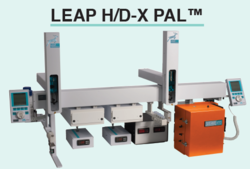
| Hydrogen Deuterium Exchange |
| Application Type | |
| SPECIAL | |
| Application ID | |
| HD-X PAL | |
| Description | |
| Automated Sample Prep for HD-X |
Contents |
General Description
Hydrogen Deuterium Exchange (HD-x) is an experimental technique to obtain structural data on proteins. It relies on the accurate measurement of the degree of labeling of the protein by deuterated hydrogen during a precisely measured labeling interval. The labeling reaction is stopped by addition of a quenching reagent, and loss of label between the quench step and analysis (usually by LCMS) is minimized by keeping the reactants at a temperature close to zero degrees Celsius.
The technique is difficult to perform manually due to the demands for precise timing and reproducing exactly the same experimental conditions. Automation solves both of these challenges. LEAP Technologies has developed a robotic solution to the sample prep and introduction to the LCMS. It consists of a Twin PAL workstation configured as shown below. There are two cooled zones on the workstation: A cooled stack at 1oC for the samples and labeled reactants and a cooled chromatography module which contains the injection valve, the column selection valvesand the columns themselves. These are maintained also at around 1degree C. Recently, LEAP has introduced a version for UPLC using the TRIOVS valving system. The automation process is controlled using LEAP Shell software.
Significant Markets
- Pharmaceutical - Drug Discovery
- Academia - Protein structural studies
Protein Structure
Protein function is strongly related to their tertiary structure and conformation. Chemical interactions which change this conformation can significantly affect protein functionality. This is important in studying disease states or effectiveness of drug candidates.
There are 3 commonly used techniques to study protein structure:
1. Crystallography
2. NMR
3. HD Exchange
HD Exchange is a good approach in cases where there is insufficient sample (NMR) or the protein will not crystallize. It relies on the accurate measurement of the degree of labeling of a protein by deuterated hydrogen during a precisely measured labeling interval. The deuterium is exchanged with hydrogen atoms on the exposed amide backbone of the protein and depending on the which regions are exposed and how the protein is folded, differences are seen in the MS spectra of the digested protein when compared with non-labeled proteins.
Labeling time is important (exposure time of the protein to Deuterium) as is prevention of "back-exchange" after the labeling has occurred. This is the natural tendency of normal hydrogen to replace the deuterium after the label is removed. This is minimized by reducing the temperature of the mixture to close to zero degrees Celsius.
What is an HD-X experiment ?
Performing H/D exchange experiments manually involves setting up many labeling mixtures then quenching these mixtures at precisely timed intervals (by changing the pH) and then injecting them onto a chilled injection valve to the LCMS. In most cases a range of label times is used, from 10 seconds to several hours. Sources of error (apart from normal liquid handling inaccuracies) are timing errors, and degradation of sample due to "back-exchange". All of these sources of error are eliminated using the automated system described here.
What does the H/D-X PAL do?
The instrument has two cooled zones for sample storage and labeling. The injection valve is chilled to 1 degree Celsius and includes a solvent pre-chiller and column selection valve for in-line protein digestion.
A typical experiment would consist of around a dozen time points for each protein sample, ranging from 10 seconds to 8 hours. The PAL system will schedule the experiments and perform each of the following 3 steps for each time point and sample:
Labeling The protein is mixed with a Deuterium reagent and incubated for a precisely timed interval at room temperature.
Quenching The labeling reaction is stopped by transferring a volume of the mixture to an excess of quenching reagent in a pre-cooled vessel.
Injection A measured portion of the quenched reactants is injected into a multi-column, multi-valve LCMS system. This step is synchronized with the analytical system using hardware signals. The PAL will inject samples as the LCMS system becomes ready. Labeled and quenched reactants are held in the cooled stack until they have been injected and analyzed.
Software Control
LEAP H/D-X PAL™ is an easy-to-use system that provides an automated process for scheduling and experimental execution of H/D-X experimental workflow. By use of the advanced HDX Director scheduling software, experimental design is simplified and reliable. Reagent addition and sample labeling steps are automatically scheduled to increase throughput and produce high quality data.
HDX Director Software
General
• Compatible with Windows XP, WIN 7 (32 and 64-bit) Operating Systems.
User Interface
• Functionally dedicated to HDX labeling experiments.
• Maximum ease of use for setting up experiments.
• Maximum flexibility for handling all HDX labeling and digestion scenarios.
• Pre-scheduling graph depicts experimental time-line before run.
• Real-time Graphic display of Labeling Schedule
• Full data logging and real-time display of experiment status.
Labeling Process
• All label experiments handled identically for uniform results down to 10 sec.
• Built-in Method option for Quench Hold before digestion.
• Built-in Method option for Dilution after quench.
• Trap washing and pepsin column washing capabilities.
Scheduling
• Powerful scheduling software for optimized Mass Spec runtime.
• Long label experiments are set up early where possible.
• Automatic test runs capture time parameters which are saved with methods.
Why Automate?
- Minimize variability
- Better quality data
- Higher confidence in results
- Walk-away convenience
- Overnight experimental runs
- More time for data analysis
- Software control of complex timing
- Allows more data points
- Multiplexing of several proteins in one experiment
What are the challenges?
- Temperature Control
- Quenching at low temp
- Digestion and Separation at Low temp
- Precise Timing
- Labeling series should be handled non-sequentially
- Scheduling algorithm to avoid conflicts
- Synchronization of steps with detection system
- Liquid Handling
- Volumes range from 5ul to 5ml
- Precision
Useful links
![]() HXMS.com A good general reference site on HD Exchange theory and practice
HXMS.com A good general reference site on HD Exchange theory and practice
![]() ASMS Interest Group - Hydrogen Exchange and Covalent Labeling
ASMS Interest Group - Hydrogen Exchange and Covalent Labeling
![]() LEAP Website H/D-x product description
LEAP Website H/D-x product description
Publications
![]() American Chemical Society 2006. Chalmers
American Chemical Society 2006. Chalmers
![]() Poster from ASMS 2006
Poster from ASMS 2006
![]() Poster ASMS 2006 Washington Univ. In St Louis
Poster ASMS 2006 Washington Univ. In St Louis
Other Reference material
![]() LEAP HDX Flyer
LEAP HDX Flyer
![]() Comparison of Data Processing software
Comparison of Data Processing software
Unique Solutions
HD-X with Waters Valves and Injector
HD-X with ambient tray holder and 3 drawer cooled stack
Videos of PAL
![]() LEAP's PAL Application Videos on YouTube
LEAP's PAL Application Videos on YouTube
![]() Proteomics Movie on YouTube
Proteomics Movie on YouTube
Hydrogen Deuterium exchange (HDX)or (HDE)is a Mass Spec technique which compares the amount of Deuterium which remains bound to the backbone of protein fragments after various stages of digestion and labeling. This information can be extrapolated by powerful data processing software into a map showing which parts of the proteins are exposed and which are shielded from the surrounding hydrogen in aqueous solution. This data provides valuable information about the protein structure and the effects of various ligand binding reactions on structure. It offers unique information which cannot currently be obtained by other techniques such as NMR or crystallography. Even now, most H/D-exchange experiments are performed only in academic institutions with all the sample preparation, labeling, digestion steps and injections done manually. The technique has been slow to catch on because such experiments are considered quite difficult to perform well. Significant inaccuracies occur due to imprecision of timing and temperature. LEAP provides automated workstation instrumentation solutions based on the LEAP CTC PAL X, Y, Z syringe only autosampler robot from LEAP Technologies. This extremely flexible, precise, and adaptable liquid handling robotic platform is available in a variety of lengths and options depending on the requirements of your sample preparation and injections for your UHPLC, LC or GC chromatography.LEAP offers full support and service for the PAL platform in addition to being able to write custom macros, cycles, and scheduling to your applications. Please contact LEAP Technologies on how we can help you get maximized throughput with flexible pipetting automation solutions. Keywords: Protein structural studies, Deuterium labeling, Epitope mapping, Covalent labeling, NMR, Crystalography
Contact LEAP
For additional information about LEAP and the PAL Platform, please contact LEAP Technologies. |
LEAP Technologies provides fully automated sample processing workstation instrumentation solutions based on the LEAP CTC PAL X, Y, Z syringe only autosampler robot. This extremely flexible, precise, and adaptable liquid handling robotic platform is available in a variety of lengths and options depending on the requirements of your sample preparation and injections for your UHPLC, LC or GC chromatography. LEAP also offers process control systems and stand alone workstations. LEAP offers full support and service for the PAL platform with over 11 years of history with the PAL. LEAP can also write custom macros, cycles, and scheduling software for your specific applications. We're proud that LEAP is known as a productivity improver for laboratories including government labs in agencies such as FDA, USDA, EPA, FBI, Armed Forces, Homeland Security and others function more efficiently. Robotic sample prep equipment works well in government labs and challenges lab technicians to keep feeding those more samples. Analytical equipment such as chromatographs and mass spectrometers are expensive devices and also expensive to maintain. LEAP can help to keep them running and analyze samples around the clock. LEAP has most of its laboratory automation robots under GSAcontract and is eager to service and maintain everything it sells to keep your expensive lab equipment running around the clock. LEAP offers customized on-site training.LEAP Is continuing to develop FAQ, Solutions, Tips & Techniques,a Learning Center with the LEAP Wiki for the benefit of all PAL Platform Robotic users. Our aim is to be the ultimate knowledge base on everything related to the PAL. LEAP has extensive multi-vendor experience with integrating the PAL. We have the Quality, Training, Parts availability, Infrastructure, and Experience.LEAP is sometimes referred to as an Application Automation House who is continually adding new products and solutions to its Lab Automation line. As we do so we change the content of this web site so please check back.
Please contact LEAP Technologies on how we can help you get maximized throughput with flexible pipetting automation solutions whether it is our standard applications or customized to your needs. LEAP provides automation that fits your needs and reduces errors, increases sample capacity, increases efficiency, reduces cost by supplying long term productivity improvements with user friendly software and flexible hardware.Customize your PAL robotic platform with LEAP Technologies.

